Safety Features to Look for in an Electric Hospital Bed
Electric hospital beds are an essential part of modern healthcare. They provide comfort for patients and make caregiving easier. However, safety is a top priority when choosing the right hospital bed.
To use a hospital bed safely, it’s important to look for safety features that help prevent falls, injuries, and discomfort, ensuring a secure environment for patients. These features also support caregivers by reducing strain and making patient care more efficient. For added safety, some beds include CPR functions, battery backups, and alarms to alert caregivers during emergencies.
Hence, it is important to choose a bed with strong safety features for better care and low risks. If you’re looking for a reliable electric hospital bed to use safely, explore our range of safe and easy-to-use options today!
Electric Hospital Beds
Key Safety Features to Consider in Electric Hospital Beds For Patients
Electric hospital beds are designed to keep patients safe and comfortable. Here are the essential safety features to look for.
However, if you want to learn more about how electric hospital beds work and their benefits, check out this detailed guide: Everything You Need to Know About Electric Hospital Beds.
1. Side Rails
Side rails are barriers attached to the sides of the bed. They help prevent patients, especially those who are weak or confused, from falling out of bed. They come in different styles, like full-length or half-length, and some can be removed when not needed.
Hospital Bed with Rails
These are particularly useful in preventing patients from sliding down from the hospital bed, which can cause discomfort or injury. It's important to choose beds with adjustable or collapsible side rails to ensure easy access and minimize the risk of patients feeling trapped.
2. CPR Function
In critical situations, like when CPR is needed, this feature flattens the bed instantly with a quick-release button. This feature can be activated manually or electronically, enabling rapid response during critical situations.
For instance, some Electric Hospital Bed like YA-D5-11 includes a manual CPR function on both sides, allowing caregivers to swiftly initiate resuscitation procedures.
3. Fall Detection and Alarms
Some electric hospital beds come equipped with fall detection systems and alarms. These features monitor patient movements and can alert caregivers if a patient is at risk of falling or attempting to leave the bed unassisted, allowing for timely intervention.
The alarms are designed to be loud and clear, ensuring quick response from staff. This feature is especially helpful for elderly patients or those with mobility issues, providing an extra layer of safety and peace of mind.
4. Emergency Lowering Function
This feature lets you lower the bed quickly and safely during power outages, keeping patients secure and easy to move in emergencies. It uses manual tools like hand cranks or hydraulic pumps, so it works without electricity.
Some beds even have battery backups for extra safety. It’s designed to operate smoothly, keeping patients calm during critical moments. This ensures the patient stays secure, meeting NHS criteria for hospital bed at home that emphasize patient safety during power failures.
5. Entrapment Prevention
The bed is designed to reduce gaps where arms, legs, or heads could get stuck, preventing injuries. It includes smooth edges, tight-fitting mattresses, and strong guardrails. Some beds have alarms to warn caregivers of risks.
It meets NHS safety standards for maximum protection. Regular inspections keep the bed safe and reliable for patients.
Additional Helpful Features in Electric Hospital Bed for Caregivers
Electric hospital beds come with features that not only enhance patient safety but also make caregiving easier and more efficient. Discover how these features improve patient care and comfort in our detailed guide, here.
1. Locking Mechanisms
Wheel locks are essential for keeping the bed stable. When engaged, they prevent the bed from rolling or moving unexpectedly, which is especially important during patient transfers or when the bed is being adjusted. You can check our most affordable electric beds with floor lock system.
Bed frame locks add an extra layer of safety by ensuring the bed’s position stays fixed. This prevents accidental changes to the bed’s height or angle, which could cause discomfort or injury to the patient. Together, these locks provide a secure and stable environment for both patients and caregivers.
2. Weight Capacity
Every hospital bed has a specific weight limit, and it’s important to choose one that matches the patient’s needs. However, exceeding the weight limit can damage the bed’s motor or frame, making it unsafe to use.
A bed with the right weight capacity ensures stability and prevents accidents, such as the bed tipping or breaking. Always check the manufacturer’s guidelines to ensure the bed can safely support the patient’s weight.
3. Battery Backup
This feature allows caregivers to adjust the bed’s position, even when there’s no electricity. For example, if the bed is raised and the power goes out, the battery backup lets you lower it safely. This is especially important in emergencies, ensuring the patient’s safety and comfort are not compromised.
A good battery backup should last long enough to handle extended outages, giving caregivers peace of mind and ensuring uninterrupted care. Always check the battery’s lifespan and recharge time to ensure it meets your needs.
4. Adjustable Height
An electric hospital bed with adjustable height helps both patients and caregivers. Caregivers can raise the bed to a comfortable level, making it easier to care for the patient without straining their back. Lowering the bed helps patients get in and out safely, reducing the risk of falls and giving them more independence.
Adjustable Hospital Beds
It also helps prevent patients from sliding down from the hospital bed by allowing proper positioning. Some beds, like the Descend Ultra-Low Floor Hospital Bed, can go as low as 2.7 inches and as high as 25 inches, making them suitable for different needs.
5. Control Panel Safety
The control panel of a hospital bed should be easy to use and secure. A good control panel helps caregivers adjust the bed smoothly while preventing accidental changes. Some beds have a lockout function, which means only trained staff can make adjustments.
This helps keep the hospital bed for home use in the right position for the patient’s safety. Locking the remote also prevents unwanted movements, reducing the risk of falls or pressure sores.
6. Easy-to-Use IV Poles
Many hospital beds have IV poles built into them. These poles make it easy for caregivers to give IV fluids and medicines without moving the patient. They also keep the IV lines neat and tidy, which helps prevent tangling or accidental pulling.
For safe use of hospital beds, caregivers should make sure the IV pole is securely attached and in the right position. Checking the IV lines regularly for tangles or problems helps keep everything safe and running smoothly.
Extra Features to Boost Electric Hospital Bed Safety and Comfort
When choosing an electric hospital bed for homecare, there are a few features of patient bed to keep in mind to ensure maximum safety and comfort:
-
Mattress Compatibility
The mattress should fit the bed perfectly to avoid gaps or slipping. A well-fitted mattress prevents pressure sores and ensures the patient stays comfortable and secure. Read out how hospital beds mattress works with alternating pressure.
Hospital Bed Mattress
-
Durability and Build Quality
Look for a bed made from strong, high-quality materials. A durable bed can handle daily use and lasts longer, reducing the risk of breakdowns or accidents.
-
Certifications and Standards
Make sure the bed meets safety standards, such as those set by the FDA or ISO. These certifications ensure the bed has been tested for safety and reliability.
-
Ease of Cleaning
Hospital beds should be easy to clean to maintain hygiene. Look for beds with smooth surfaces and minimal crevices where dirt or germs can collect.
-
Noise Level
A quiet bed motor ensures the patient can rest without disturbance. It also makes the caregiving process smoother and less stressful.
-
Assessment Bed in a Care Home
When selecting a bed for a care home, an assessment bed can be used to evaluate the patient’s specific needs. This ensures the chosen bed has the right features of a patient bed, such as adjustable height, side rails, and entrapment prevention, to provide optimal care.
Tips for Choosing a Safe Bed for Home or Facility Use
Choosing the right electric hospital bed is crucial for ensuring safety and comfort. Here are some simple tips to help you make the best decision:
Medical Bed for Home
-
Check Safety Features: Look for side rails, locking mechanisms, and emergency lowering to prevent falls and ensure stability.
-
Ensure Battery Backup: Keeps the bed working during power outages for uninterrupted care.
-
Evaluate Mattress Compatibility: Choose a mattress that fits well to prevent slipping and pressure sores.
-
Check Certifications: Make sure the bed meets safety standards like FDA or ISO for reliability.
-
Think About Ease of Use: Pick beds with simple controls and easy assembly for caregivers.
-
Consider the Patient’s Needs: Look for features like tilt functions or extra padding for specific medical conditions.
Shop Electric Hospital Beds at Sale with MedShop Direct
Electric hospital beds are a vital tool for ensuring patient safety and caregiver efficiency. With features like locking mechanisms, emergency lowering, and adjustable height, these beds provide a secure and comfortable environment for recovery.
Whether for a care home or home use, selecting the right bed with the necessary safety features is essential for quality care.
Hospital Beds for Sale
If you’re looking for a reliable electric hospital bed, shop electric hospital beds on sale at MedShop Direct. Explore our range of high-quality, safe, and easy-to-use hospital beds designed to meet your needs.



















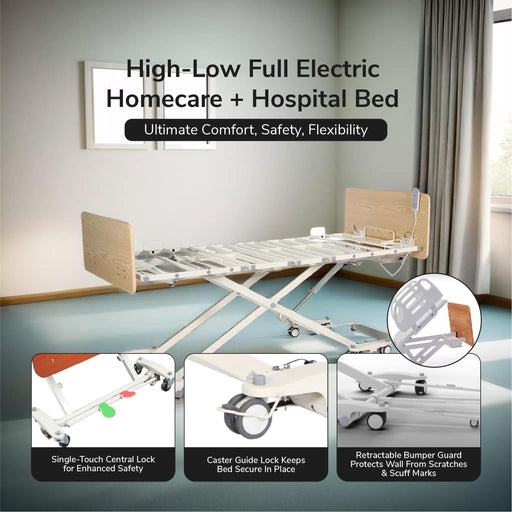
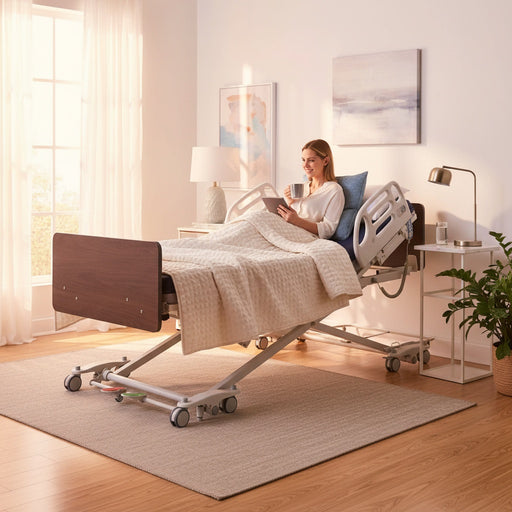
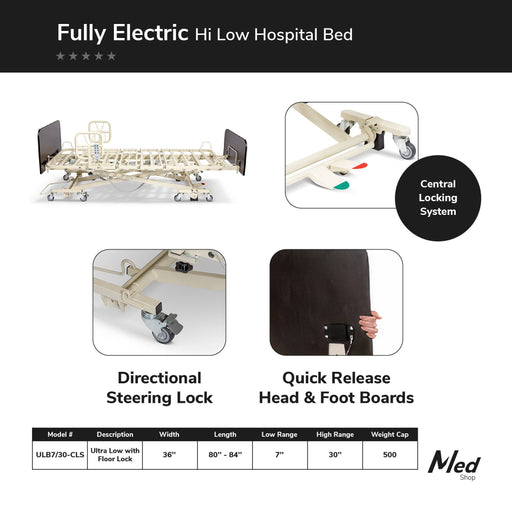
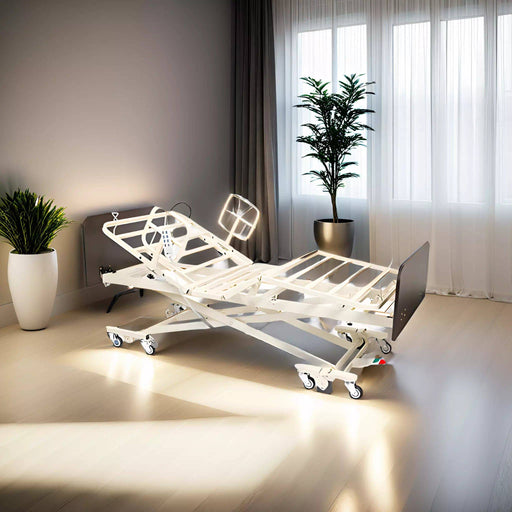


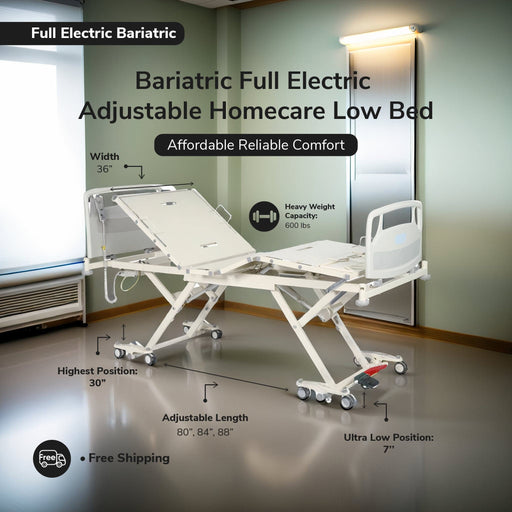
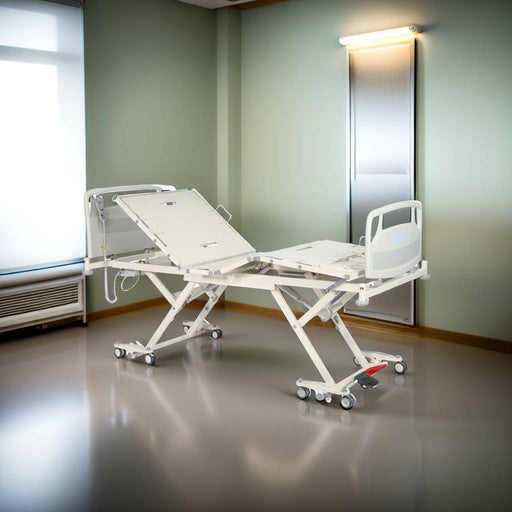
Leave a comment